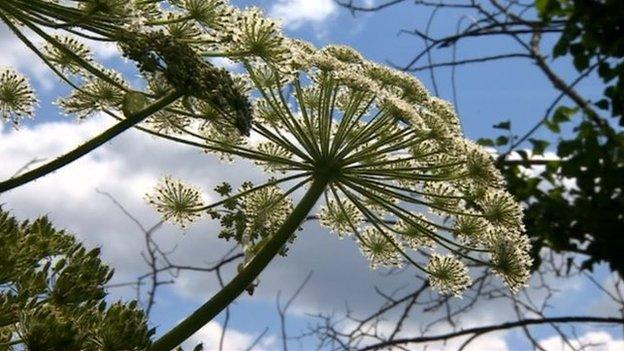Who, What, Why: How common is Giant Hogweed?
- Published

Two boys were hospitalised with burns in Bolton after touching a plant called Giant Hogweed. But how common is it, asks Alex Morrison.
"Wherever you live in the UK, you can expect to encounter this plant," says Guy Barter of the Royal Horticultural Society. Heracleum mantegazzianum - known as Giant Hogweed - is part of the carrot family and is common on riverbanks and wasteland, he says, adding that some people "unwisely" have it in their gardens.
The plant, a close relative of cow parsley, has white flowers, thick bristly stems and can grow more than 16ft (5m) tall. Native to Central Asia, it was introduced into Britain in 1893 as an ornamental plant but "escaped from domestication", external.
Toxic components in the leaves, stems, roots, flowers and seeds can be transferred to skin by touch. These do not cause burning alone - but they make skin sensitive to sunlight, which can then cause rashes, burns and severe blistering. These effects may not start straight away - often appearing 24-48 hours after exposure.
The Centre for Ecology and Hydrology says severe blistering can "recur for many years". It says Giant Hogweed "causes damage to DNA", adding: "Contact with the cut material in sunlight produces a reaction in almost everyone. The degree of symptoms will vary between individuals, but children are known to be particularly sensitive."
The NHS says, external anyone who touches Giant Hogweed should wash the area of skin with soap and water, and keep it covered.
A Giant Hogweed plant can produce up to 50,000 seeds per year, and Barter says it is "important to stop it seeding" - though there is no legal obligation, external in the UK to remove or control the plants. Protective clothing should be worn when dealing with the plant, external.
Subscribe to the BBC News Magazine's email newsletter to get articles sent to your inbox.